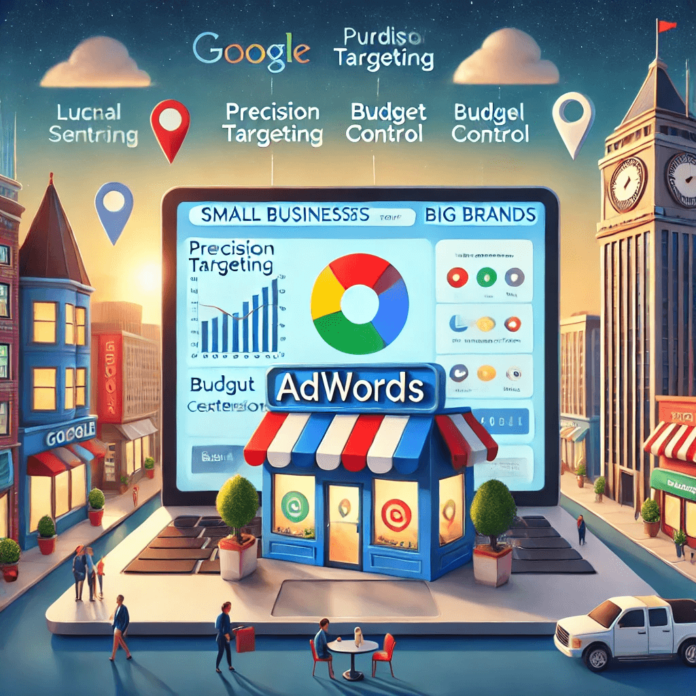Introduction
In the battle of small business vs big brand marketing, Google AdWords provides an effective way for smaller companies to compete with larger competitors without breaking the bank. With strategic targeting and affordable PPC for small stores, local businesses can attract customers, build brand awareness, and increase sales. AdWords allows small businesses to focus on local audiences, control budgets, and create personalized marketing campaigns that resonate with their customers. In this guide, we’ll explore how Google AdWords can help small businesses level the playing field and achieve marketing success.
Small Business vs Big Brand Marketing: Winning Strategies for Local Success

When it comes to small business vs big brand marketing, competing with larger competitors may seem challenging, but it’s entirely possible with the right strategies. Small businesses have the advantage of offering personalized service, niche expertise, and a local touch that big brands often lack. By leveraging digital marketing tools like Google AdWords, social media, and content marketing, small businesses can build a strong presence and attract loyal customers.
1. Targeting the Right Audience with Precision
One of the biggest advantages of Google AdWords is its ability to provide precise audience targeting. Unlike traditional advertising, where businesses have to cast a wide net, AdWords allows small businesses to focus their budget on reaching potential customers who are most likely to convert.
How AdWords Helps:
- Geotargeting: Small businesses can target customers in specific locations, ensuring their ads appear only to local audiences.
- Demographic Targeting: Businesses can narrow their audience based on age, gender, income, and interests.
By focusing on the right audience, small businesses can make the most of their ad spend and avoid wasting money on irrelevant clicks.
2. Budget Control and Cost-Effectiveness
A common misconception is that online advertising is expensive and only affordable for big brands. However, Google AdWords offers flexible budgeting options that make it accessible to small businesses.
Key Budgeting Features:
- Set Your Own Budget: Small businesses can set daily or monthly budgets that fit their financial capabilities.
- Pay-Per-Click (PPC) Model: Advertisers only pay when someone clicks on their ad, ensuring they get measurable results for their investment.
With careful planning and optimization, small businesses can achieve a cost-effective advertising strategy that delivers high returns.
3. Competing with Local Search Optimization
Big brands may dominate national campaigns, but small businesses have the advantage when it comes to local search optimization. Many consumers search for products and services “near me,” giving small businesses an opportunity to capitalize on local demand.
How AdWords Supports Local Competition:
- Google My Business Integration: AdWords campaigns can be linked to Google My Business listings, showing store location, hours, and reviews directly in search results.
- Local Service Ads: These allow businesses to appear at the top of search results with a “Google Guaranteed” badge, building trust with potential customers.
- Call Extensions: Small businesses can add their phone number to ads, making it easy for customers to contact them directly.
By focusing on local searches, small businesses can dominate their niche and compete effectively with big brands in their area.
4. Leveraging Ad Extensions for Greater Visibility
Google AdWords offers ad extensions, which allow businesses to expand their ads with additional information, making them more attractive and informative than those of larger competitors.
Common Ad Extensions for Small Businesses:
- Sitelink Extensions: Direct users to specific pages, such as promotions or contact pages.
- Callout Extensions: Highlight key selling points like “Free Estimates” or “Locally Owned.”
- Structured Snippets: Showcase product categories or service offerings.
- Location Extensions: Display business addresses and directions, making it easier for local customers to find the store.
Using these extensions helps small businesses create a more compelling ad presence that can rival or even surpass big brands.
5. Compelling Ad Copy to Stand Out
A well-crafted ad copy can make all the difference in grabbing attention and encouraging users to click. Unlike large corporations, small businesses can create personalized, authentic messaging that resonates more with their audience.
Tips for Effective Ad Copy:
- Focus on unique selling points (e.g., “Family-Owned,” “Best Prices in [City],” or “Personalized Service”).
- Use action-driven language such as “Book Now” or “Call Today.”
- Include promotions, special offers, or discounts to attract clicks.
- Utilize social proof, such as customer reviews or testimonials, to build trust.
By crafting authentic and locally relevant ad copy, small businesses can connect better with their audience and differentiate themselves from big brands.
6. Remarketing: Stay Top-of-Mind
Another way small businesses can compete with big brands is through remarketing. This powerful AdWords feature allows businesses to re-engage users who have previously visited their website but didn’t make a purchase.
Benefits of Remarketing:
- Keep your brand in front of potential customers as they browse other websites.
- Increase conversion rates by reminding users of their interest in your products or services.
- Offer exclusive discounts to entice visitors to return and complete a purchase.
Remarketing is a cost-effective way to stay top-of-mind without constantly competing for new customers.
7. Measuring Success with Analytics
Unlike traditional marketing methods, AdWords provides real-time data and insights that allow small businesses to track their performance and make data-driven decisions.
Key Metrics to Monitor:
- Click-Through Rate (CTR): Measures the percentage of users who click on the ad.
- Cost-Per-Click (CPC): Evaluates how much each click costs.
- Conversion Rate: Tracks how many clicks turn into leads or sales.
- Impression Share: Helps determine how often ads are shown compared to competitors.
By analyzing these metrics, small businesses can continuously optimize their campaigns and improve their ROI.
Conclusion
Google AdWords provides small businesses with the tools and flexibility needed to compete with big brands effectively. From precise audience targeting and budget-friendly options to local search optimization and remarketing strategies, AdWords levels the playing field by enabling small businesses to reach their ideal customers and grow their business.
By leveraging the power of Google AdWords, small businesses can maximize their advertising potential, increase brand awareness, and drive meaningful results without needing massive budgets.














